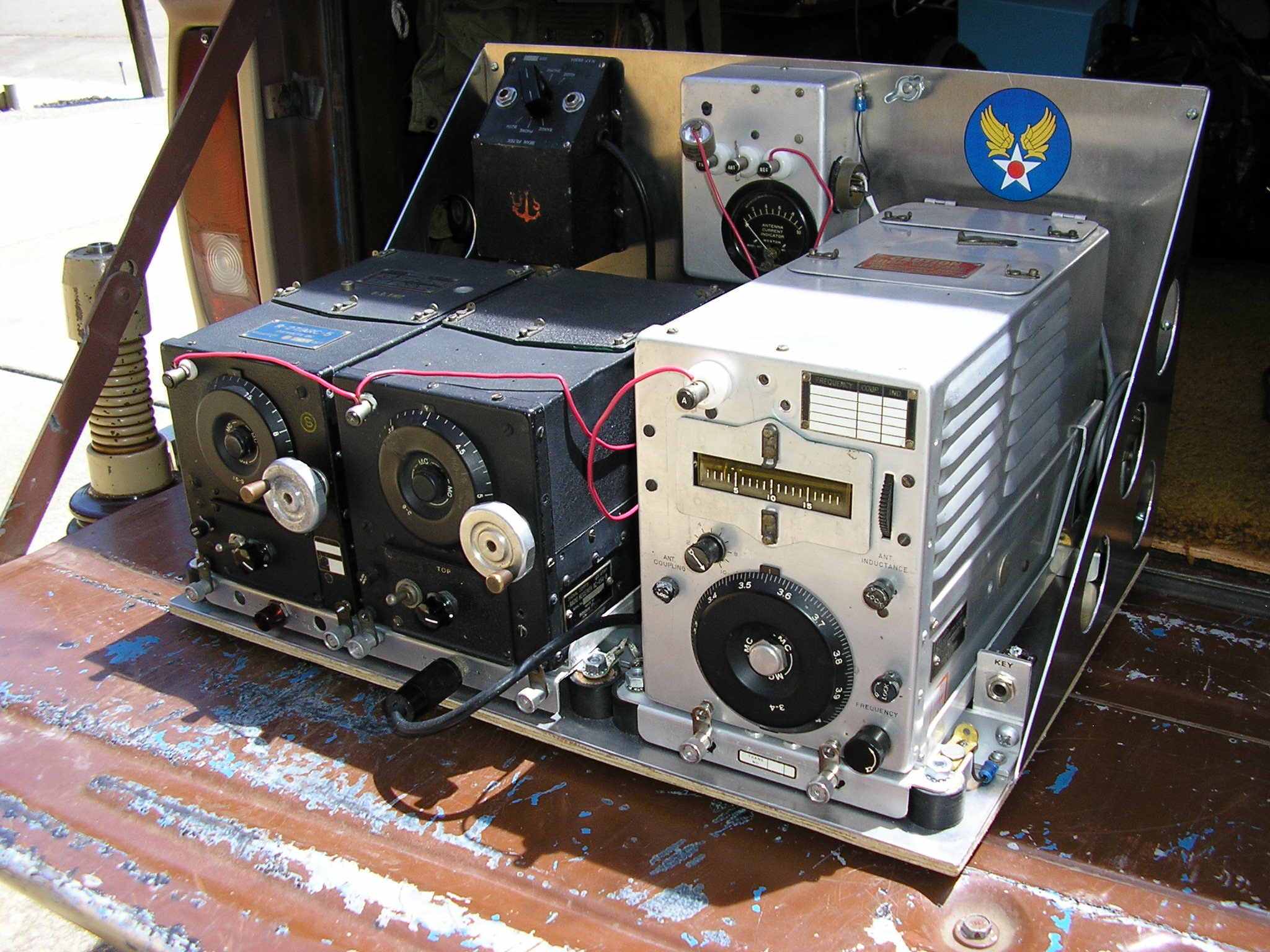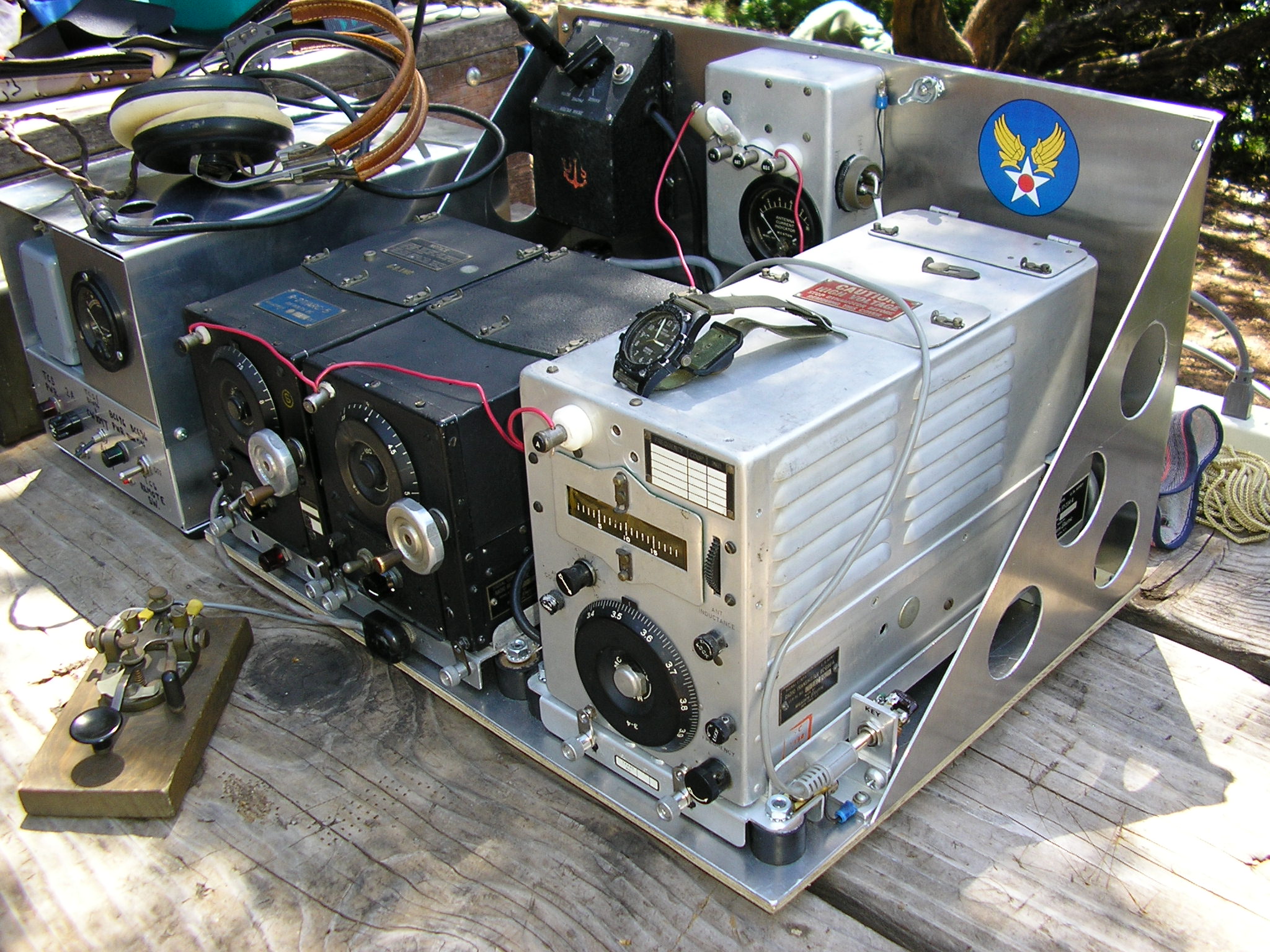
UPDATED 5/8/18
Most seasoned Hams grew up with these radios: transmitters, receivers or both. Designed for high frequency AM Voice (mostly) or CW aircraft-to-aircraft communications during WWII, they performed the function of “command”, hence their common name. They could also serve as “liaison” radios for comms back to base but that function was better suited for the more powerful transmitters like the BC-375 in larger aircraft. There is a wealth of information on the Web regarding this equipment, both WWII and more modern descriptions. The best is the series by Walt Huchins in Electric Radio magazines.
Here I will discuss my particular set and its use in the field. The following photos shows my current CW system, A BC-696 transmitter and ARC-5 receivers. I have owned the receivers since 1964 and long-ago modified them for 12 volt filament operation. The transmitter was a flea-market find and it had also been previously modified for 12 volt filaments and missing the “TX Select” relay. Otherwise in good mechanical shape save for the power connector (octal). Getting hard to find pristine un-Hammered NOS radios these days so I worked with what I had. Command Set purists would be horrified!
The TX sits in a single TX rack, the RX’s sit in what was previously a 3 RX rack that a previous owner modified to a two-RX configuration. As yet no shock mounts, few connectors, no Control Box etc. I figured I would work with this, the results are shown. I build a “shelf” similar to the one found in the B-17 bomber and I added the TX-RX antenna relay with RF ammeter and the 1020 cps “beam filter” that actually works pretty well on CW with these radios. I modified an AC supply I had previously built for my TCS system and it now powers both radio systems.
Here’s our Killer Cat supervising the construction of the Command Set system. He has learned not to wag his tail around here…..

In the photo below, The left RX is 6 – 9.1 Mc (for 40 meters), the other covers 3 – 6 Mc (for 80 meters) and the transmitter shown here is the BC-696 covering 3-6 Mc (80 meters). I have another transmitter for 40 meters that I can just plug in to replace the 80 meter TX when I change bands, just switching the RX filament voltage over to the other receiver. Works great.
I have since captured an MD-7 modulator and I am planning to build another “shelf” like this one to hold the modulator and an LM-14 Freq meter as well. Still thinking about how I will power that system…going back to a 28 Volt dynamotor to power the TX/MD-7 would take some doing although I do have a 12 volt dyno for the receivers. The “Wonderful World of Tradeoff’s”…
Still looking for suitable ARC-5 transmitters to keep everything “in the same family”. Yes, I would prefer a pristine system with all the correct (ARC-5 or SCR-274N) parts but that will take more time – I feel that getting it on the air today is better than having it sit on a shelf in the garage forever awaiting “unobtanium parts”. I’ll get there – just takes time.

Below is a photo of the system set up at a riverside campsite; deployed for “Vintage Field Day” sponsored by Electric Radio magazine. That’s the 80 meter transmitter on the right, waiting to be plugged in upon nightfall.
I was running the system from a Honda EX-1000 generator for AC power. It’s a good “camp” generator, starts reliably, is reasonably quiet but it radiates terrible ignition noise. (See the post on the Honda EX-1000 generator for more details). A piece of bare ground wire, tied to a rock and thrown in the river makes a good ground connection.

Command Set and GRC-109 Vintage Field Day in the mountains – N6CC
The system works pretty well if the bands aren’t too crowded, the receivers of course being fairly broad. They are quite sensitive, even with a simple wire antenna laying on the ground. I usually run either a dipole or random wire. I carry a 200 pf air variable capacitor that I can connect either in series with the antenna or in parallel with the transmitter-to ground. This “simulates a B-17 bomber antenna system”. Just tune up and adjust the variable cap for desired loading on the Pa plate meter while getting max RF antenna current. Pretty flexible, non fussy tuneup. Both TX’s key pretty cleanly although I am running regulated oscillator and screen voltages from the AC power supply.

Command Set in the field – N6CC

Military Field Day Command Set and Friends N6CC
Above: My 2006 “Vintage Military Field Day” setup on Mt. Diablo (CA). The Command Set along with some vintage friends: A GRC-109 and an RS-6 being set up for CW ops.
Below: Another shot with buddy “Army Al” and our perimeter defense force in our Forward Operating Base (FOB) waiting for breakfast to cook. Yep – it’s a cheesy photo.

Army and Navy – Vintage “Military” Field Day on the river – N6CC
I have gotten good reports from home and in the field. One can imagine an enterprising Army Air Forces radio technician lashing up a system like this from parts cannibalized from crashed aircraft. An “Improvised Advanced Base” I think they would have called it until the real gear began showing up. It’s a fun campsite radio and it gets lots of curious looks from the occasional Forest Ranger who can actually find us and check for our camp fire permits.
Great setup for your command sets. Glad to see them in operation.
We have here for camping (sheep dog trials) a couple of the Honda 2000 watt generators. I have not tried radio when they were running, but may well do this Summer. I wonder if they have ignition noise? Going to now find your article and see if you have any cures.
GO Navy (Flew H-3 helos.)
Roy
Upstate NY
k1lky@earthlink.net
Hi Roy – Well my Honda EX-1000 had very bad ignition noise, at least on HF radios. Take a look at my Posting here for some ideas on how I attacked that problem. http://www.n6cc.com/honda-ex-1000-generator-problems
It is an otherwise pretty good generator but needed significant work to quiet the ignition noise…Now it’s pretty useable in the field…
OK on the H-3’s…Thanks for your service!
Go Navy!
Tim
Thanks for the link in the group.
Those are some fine looking radios. I like to see fine older radios in use. Before I was a ham I played with quite a few surplus ARC-5 sets. Now that I am a ham I no longer have the time to work with some of the radios I would like to use.
That is a great set-up and your location looks perfect and not just for Field Day.
Hi Bill – Well this setup won’t win any “historically accurate” contests but it is a lot of fun to use. “real radio….”
Ham radio and camping are a great combination hobby – my camping gear is equally Vintage!
Thanks for stopping by!
73, Tim
Nice equipment! I am restoring an SNJ-5. How does one find the old radios for old vintage airplanes.
Thanks
Ben
Hi Ben – Thanks for stopping by. Sounds like a neat project with the SNJ! I am no expert on vintage A/C comm gear but those planes may have had the SCR-183 Command Sets. They are an earlier, functionally similar set to the set on the web post. As you do the restoration work on your SNJ I am sure you will find the proper references to the installed equipment (which may have been reconfigured over the life of the A/C.) Take a look here on a nice webpage on the SCR-183. http://aafradio.org/flightdeck/1935/SCR-AE-183.html
The component parts for these sets occasionally show up on E Bay and sometimes at “Hamfest” swap meets. A lot of this equipment was built over the years but it is getting increasingly harder to find – which I am sure also describes vintage A/C parts! LOL
You might also join the ARC-5 Yahoo Group – lots of expertise there on the whole line of Command sets over the years. Looking forward to seeing and hearing your SNJ! Good luck!
Tim
Hi Tim,
very beautiful installation, you have made. I know, it is very fine working with it in the 80 meterband. We here in Holland, we are much qrv on 3705 kc in AM. It gives much fun.
I think, you are a very good home builder, it looks very nice, professionel! Go on with the good work.
73 Peter, PA0PZD, Meppel, The Netherlands.
Hi Peter – Many thanks! It has been a fun project but now to add the AM Modulator and LM frequency meter. In California and the west coast of the US we use 3985 and 3885 primarily. Lots of AM stations out here as well.
73 and thanks for visiting my website!
Tim
I have several of these xmtrs that I am threatening myself to do something with.
Tnx fer the nice site & Vy 73,
KA4NNN
Hi Presley – Hard to explain, but this old gear is way more fun to play with than commercial plastic “turn key” stuff. Lots of character!
Thanks for stopping by,,,73, Tim
De Michel F1cow
As for your problem of ignition noisewith the Honda group, try putting ferrite clamps as used on computer cables, on the spark plug cable AND on the AC output cables.
It made marvels on VHF contest stations, for lower frequencies, try using several of them.
73 from Michel F1cow
Hi Michael..Thanks for checking in. I did wind some ferrite chokes for the AC output conductors and that helped with the conducted noise. I did not try ferrites on the spark plug ignition wire as I think that would absorb energy from the ignition pulse and degrade the engine performance. It would slow the pulse risetime and peak voltage but I don’t know what performance loss that may cause. Possibly difficulty starting?. Thanks for the suggestion though, I will give it a try in addition to the shielding I have already put on that cable.
Thanks for visiting my website & 73.
Au Revoir, Tim
Hello Tim!
That’s a fantastic looking setup.
I was looking for ideas to package 2 Rx and 2 Tx – and that is how I reached here..
I hope your military vintage station is still QRV.
73,
Prem
va3uma
Toronto.
Hi Prem – Thanks…This was a fun project but now I have an MD-7 modulator and an LM-14 frequency meter to include. How to package the system???
Very interesting equipment and fun to use. Good luck with yours…73, Tim
Tim,
It was good to see you this weekend. I find myself coming to your website for restoration inspiration on a regular basis. This may be an old page…but am working on a few old command sets as I find the time…and of course have too little. I need to retire like Andy (not happening any time soon). Keep up the GREAT work and write-ups.
Craig
N6CAV
Hi Craig – Likewise! Somehow the time went very fast and I (we) didn’t get enough time to get really caught up with all the troops..I really liked the venue but missed out on the operating event due to poor planning on my part.
Command Sets: Still slowly working on mine as I gather the unobtanium.. The MD-7 integration is next, I picked up a really nice BC-221 at the meet.
We are thinking of doing some kind of Op Event at MVCC Lodi in Sept. Will you be making that one?
Cheers! Tim